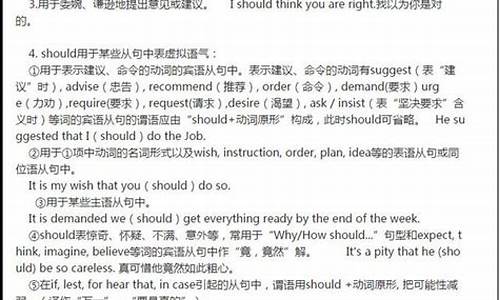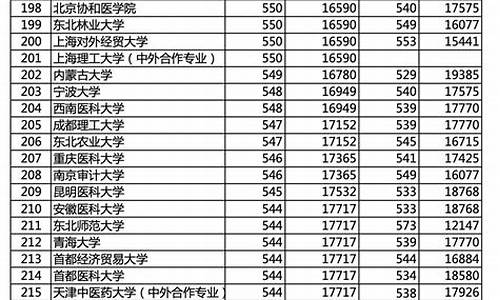您现在的位置是: 首页 > 教育新闻 教育新闻
高考动词用法-高考必考动词
tamoadmin 2024-08-12 人已围观
简介1.请列举下高考常考的英语不及物动词和用法2.高中形容词,动词意动用法举例3.动词不定式的用法4.高考英语语法有哪些5.实义动词的用法及口诀请列举下高考常考的英语不及物动词和用法英语中按动词后可否直接跟宾语,可把动词分成及物动词和不及物动词。不及物动词:字典里词后标有vi. 的就是不及物动词。不及物动词后不能直接跟有动作的对象(即宾语)。若要跟宾语,必须先在其后添加上某个介词,如to,of ,at
1.请列举下高考常考的英语不及物动词和用法
2.高中形容词,动词意动用法举例
3.动词不定式的用法
4.高考英语语法有哪些
5.实义动词的用法及口诀
请列举下高考常考的英语不及物动词和用法

英语中按动词后可否直接跟宾语,可把动词分成及物动词和不及物动词。
不及物动词:字典里词后标有vi. 的就是不及物动词。不及物动词后不能直接跟有动作的对象(即宾语)。若要跟宾语,必须先在其后添加上某个介词,如to,of ,at后方可跟上宾语。具体每个动词后究竟加什么介词就得联系动词短语了.
常用的不及物动词
ear ,Appear calm
come ,Come easy (safe)
go ,Go mad (crazy, bad, sour, wrong, crazy, hungry, blind)
get ,Get angry (ill, wet, excited, married, paid)
fall ,Fall asleep( fall ill, fall short, fall flat)
feel ,Feel good (sleepy)
keep ,Keep quiet (silent)
look ,Look fit (well, young, tired)
make, Make certain (sure, ready, a good teacher)
prove ,Prove an effective method (correct, accurate)
remain ,Remain still (unchanged)
rest,Rest satisfied (content)
rise, Rise red
seem ,Seem hy
stand ,Stand still
stay ,Stay young (stay fresh, the same)
turn, Turn teacher =become a teacher (yellow)
turn out ,Turn out true
用法举例
Look carefully! (注意:carefully 是副词,不是名词,故不作宾语)
look at 看…….+宾语 Look at me carefully! (me是代词,作宾语)
(at是小范围 in是大范围)
如: The students work very hard.学生们很努力地学习。
She apologized to me again. 她再次向我道歉。
The accident hened yesterday evening.昨天晚上发生了事故。
与及物动词的区别
及物动词与不及物动词的区别从是否需要宾语来分,实义动词分为及物动词和不及物动词两类。
1)及物动词 后面必须跟宾语意义才完整的实义动词,叫做及物动词(transitive verb)。如: I believe that the committee will consider our suggestion.我相信委员会将会考虑我们的建议。
“How long can I keep the book ?”Harry asked.哈里问:“这本书我可以借多久?”
2)不及物动词 本身意义完整后面不须跟宾语的实义动词,叫做不及物动词(intransitive verb)。如: Birds fly.鸟会飞。
It hened in June 1932.这件事发生于一九三二年六月。
My watch stopped.我的表停了。
She spoke at the meeting yesterday evening. 她在昨天晚上的会上发了言。
3)兼作及物动词和不及物动词 英语里有不少实义动词可以兼作及物动词和不及物动词。这样的动词又有两种不同的情况:
a)兼作及物动词和不及物动词时,意义不变。试比较:
Shall I begin at once?我可以立刻开始吗?(begin作不及物动词)
She began working as a librarian after she left school.她毕业后当图书馆管理员。(begin作及物动词)
When did they lee Chicago?他们是什么时候离开芝加哥的?(lee 作及物动词)
They left last week. 他们是上周离开的。(left 作不及物动词)
b)兼作及物动词和不及物动词时,有时意义不尽相同。如:
Wash your hands before meals.饭前要洗手。
Does this cloth wash well? 这布经得起洗吗?
4) 与汉语的比较 有时英语动词的及物和不及物的用法,与汉语的用法不一样,请注意下列两种情况:
a)有的动词在英语里只能用作不及物动词,而汉语则可用作及物动词,如arrive到达,agree同意,1isten听。英语里这些动词后面常接介词。如:
We arrived at the railway station at noon.我们于中午到达火车站。(at不能省去)(比较:We reached the railway station at noon.)
Everybody listened to the lecture with great interest.每个人都很有兴趣地听讲课。(to不可省去)(比较:We all heard the lecture.)
Do they agree to the plan?他们同意这个吗?(to不可省去)
b)有的动词在英语里能用作及物动词,而在汉语里则不能用作及物动词,如serve为…服务。 Our children are taught to serve the people wholeheartedly.我们的儿童被教以全心全意为人民服务
及物动词后可以加宾语,不及物动词后不可以加宾语
动词的及物不及物是在英语学习中必须解决的首要问题。动词及物与不及物通常有以下几种情况:
a.主要用作及物动词。及物动词后面必须跟宾语。可以用于:"主+谓+宾";"主+谓+双宾";"主+谓+宾+宾补"结构。如:
He reached Paris the day before yesterday.
Please hand me the book over there.
They asked me to go fishing with them.
类似的还有:buy, catch, invent, found, like, observe, offer, prevent, promise, raise, find, forget, receive, regard, see, say, seat, supply, select, suppose, show, make, take, tell.... b.主要用作不及物的动词。不及物动词后面不跟宾语。只能用于:"主+谓"结构。
This is the room where I once lived.
类似的还有:agree, go, work, listen, look, come, die, belong, fall, exist, rise, arrive, sit, sail, hurry, fail, succeed....
c.既可以用作及物又可以用作不及物的动词,其意义不变。如begin 都是作"开始"讲。everybody , our game begins. let us begin our game.
类似的还有:start, answer, sing, close, consider, insist, read, learn, prepare, pay, hurt, improve....
d.既可以用作及物又可以用作不及物的动词,其意义完全不同。
这类动词作不及物动词是一个意义;而作及物动词时却是另一个意义。如lift作不及物动词时是指烟雾的"消散"。we saw the mountain when the clouds lifted. 作及物动词时是"升高;举起"。 He lifted his glass and drank.
类似的还有:beat vi.跳动 vt. 敲、打; grow vi.生长 vt. 种植 play vi.玩耍 vt. 打(牌、球),演奏 smell vi.发出(气味) vt. 嗅 ring vi.(电话、铃)响vt.打电话 speak vi.讲话 vt. 说(语言) hang vi. 悬挂 vt. 绞死 operate vi.动手术 vt. 操作
需要注意的一点是:少数不及物动词唯一可跟的宾语是同源宾语,如:I dreamed a dream last night.
高中形容词,动词意动用法举例
稍稍宾客其父
宾客
就是在这里形容词作动词用
形容词的意动用法是“形容词作动词用”的一种
形容词用作动词分为“使动”和“意动”两种情况。
这里宾客解释为:以宾客之礼相待
所谓意动用法,是指谓语动词具有“以之为何”的意思,即认为宾语怎样或把宾语当作怎样。
意动用法只限于形容词和名词的活用,动词本身没有意动用法。
使动用法是主语使宾语在客观上产生某种动作行为,而意动用法是主语主观上认为(或以为)宾语具有谓语所表示的内容,是存于意念的想法或看法,客观上不一定如此。一般可译为“认为......”“以......为......”等。
名词的意动用法
名词用作意动,是把它后面的宾语所代表的人或事物看做这个名词所代表的人或事物。
例1:邑人奇之,稍稍宾客其父。(《伤仲永》)
宾客:本为名词,这里活用为意动词。“宾客其父”是动宾结构,意为“以其父为宾客”。
例2:父利其然也。(《伤仲永》)
利:是名词活用作意动词。“利其然”即“以其然为利”(把这种情况视为有利可图)。
使动用法和意动用法的区别
使动:谓使动用法,是指谓语动词具有“使宾语怎么样”的意思。它是用动宾结构表达使令式的内容。
意动:认为……怎么样:余颇易之(我认为甚是简单 )
使动用法指动词谓语表示主语使宾语"怎么样"的用法。有些名词和形容词活用为使动词,表示"使......"的意思。有三种:1.动词的使动用法。如"必先苦其心志,劳其筋骨"中的"劳",意思是"使....劳累"。 2.名词的使动用法。是"使......成为......."的意思。3.形容词的使动用法。特点是使宾语表示的人或物具有这个形容词所表示的性质或状态。
意动用法表示主语认为宾语怎么样,或主语把宾语当作什么。有两种:1.名词的意动用法。例如"先破秦入咸阳者王之"中的"王",意思是"以....为王"。 2.形容词的意动用法。例如"而耻学于师"中的"耻",意思是"以为耻"。
动词不定式的用法
动词不定式用法总结 动词不定式在句中可充当主语、表语、宾语、宾补、定语和状语等。
一、作主语
动词不定式作主语可位于句首。例如:
To learn a skill is very important for everyone in society.
也可使用it作形式主语,而将其置于句末。例如:
It is necessary for young students to learn a foreign language.
动词不定式作主语的常用句型有:
1. It is+adj./ n. (+for sb./sth.) + to do sth.
用于此句型的形容词有:easy, hard, difficult, possible, important, impossible, necessary, good, bad, exciting, interesting, surprising等。例如:
It is interesting to play this game.
It is necessary for you to change your job.
It was impossible for them to complete the task in such a short time.
考例1:Is ____ possible to fly to the moon in a spaceship? (88 MET)
A. now B. man C. that D. it
用于此句型的名词有:pity, shame, pleasure, one’s duty, one’s job, fun, joy, good manners, bad manners等。例如:
What a pity it is for you to he missed such a wonderful film.
It is good manners for the young to give their seats to the old.
2. It is+adj.+of sb.+to do sth.
该句型中只能使用描述某人的品德、特征的形容词,如: kind, nice, wise, silly, polite, impolite, friendly, foolish, clever等。例如:
How rude it was of the boy to jump the queue!
It is friendly of the family to try to make me feel at home in their house.
How silly it was of you to give up such a good chance!
3. It takes sb.+some time+to do sth.
该句型意为“做某事花费某人多长时间”。例如:
It took us half an hour to ride to the town by bike.
二、作表语
动词不定式作表语常用于以下结构:My wish/ job/ aim/ goal is…及The next step/ measure is …等。例如:
Your job is to type the papers in the office.
The next measure is to stop the river from being polluted.
三、作宾语
常见的只能使用动词不定式作宾语的动词有:agree, choose, decide, hope, fail, wish, refuse, expect, manage, plan, intend, pretend, promise, offer, afford, demand, arrange等。 例如:They decided to build a highway between these two cities.
She offered to help me when I was in trouble.
believe, think, consider, feel, make等动词可用于“动词+ it +adj. / n+to do sth.”句型,其中使用it作形式宾语,而将真正的宾语动词不定式置于句末。例如:
I think it necessary for us to he a good rest after the long work.
She felt it her duty to help the old woman.
四、作宾补
可后接动词不定式作宾补的动词有:advise, allow, ask, hear, order, see, tell, want, wish, watch等。例如:
The doctor advised her no to eat too much sugar.
I wish you to go to the meeting with me.
believe, consider, count, declare, deny, feel, find, guess, imagine, judge, know, prove, realize, suppose, think等动词后可接to be型不定式作宾补。例如:
He declared himself to be a college student. 他自称是名大学生。
The police proved him to be a thief. 警察局证实他是小偷。
hope, demand, suggest等动词不能后接动词不定式作宾补。例如:
误I hope my son to be back soon.
正I hope my son will be back soon.
误She suggests us to he a discussion about it.
正She advises us to he a discussion about it.
正She suggests that we (should) he a discussion about it.
在主动结构中,下列动词后作宾补的动词不定式应省略to:“五看”(see, watch, notice, observe, look at)“三使”(make, let, he)“两听”(hear, listen to)“一感觉”(feel)。例如:
Who made him work all night long?
但是,改为被动结构后,应补出省略的to。例如:
He was seen to break the window.
五、作定语
动词不定式作定语,应位于所修饰词语之后,即:作后置定语。例如:
He you got anything to eat? (to eat修饰anything,位于其后)
下列名词后常接动词不定式作定语:ability, attempt, chance, courage, decision, effort, failure, promise, way, wish等。例如:
But she ge up the chance to go abroad.
由only, first, last, next以及序数词或形容词最高级修饰的名词后,也常接不定式作定语。例如:
Who was the last one to lee the classroom last night?
六、作状语
动词不定式作状语,可表示目的、原因、结果或条件。例如:
We went there to see our grandparents.(目的)
I am very sorry to hear that.(原因)
She hurried home only to find her father dead.(结果)
To look at the picture, you would like it.(条件)
作目的状语,还可以使用in order to或so as to。例如:
The boy worked so hard in order to make up for the lost time.
结果状语还可以使用enough to, too…to…, so…as to, such… as to等结构。例如:
He got up too late to miss the early bus.
She was in such a hurry as not to notice me. 她如此匆忙,以致没有注意到我。
高考英语语法有哪些
一.非谓语动词
一.不定式:
一)不定式的常考形式:
1) 一般形式:He decided to work harder in order to catch up with the others.
被动形式: He preferred to be assigned some heier work to do.
语法功能: 表示与谓语动词同步发生
2) 完成形式:He pretended not to he seen me.
被动形式:The book is said to he been translated into many languages.
语法功能:表示发生在谓语动词之前
二)不定式常考的考点:
1)不定式做定语----将要发生
2)不定式做状语----目的
3)不定式充当名词功能---To see is to believe.
三)不定式的省略
1)感官动词 see, watch, observe, notice, look at, hear, listen to, smell, taste, feel
+ do 表示动作的完整性,真实性;
+ doing 表示动作的连续性,进行性
I saw him work in the garden yesterday.
昨天我看见他在花园里干活了。(强调"我看见了"这个事实)
I saw him working in the garden yesterday.
昨天我见他正在花园里干活。(强调"我见他正干活"这个动作)
" 感官动词后面接形容词而不是副词:The cake tastes good; It feels comfortable.
2) 使役动词 he bid make let 等词后不定式要省略但同1)一样被动以后要还原to
I 'd like to he John do it.
I he my package weighed.
Paul doesn't he to be made to learn.
3) help help sb do help sb to do help do help to do
四)有些动词后只跟不定式如:
want,wish,hope,manage,promise,refuse,pretend,plan, offer,decide,agree,expect allow sb to do, cause sb to do , permit sb to do, enable sb to do
force sb to do. be more likely to do love to do warn sb to do be able to do
be ambitious to do. begin to do . start to do
We agreed _______ here,but so far she hasn't turned up yet.(NMET
1995)
A.hing met B.meeting C.to meet D.to he met (Key:C)
五) 有的时候to后面要接-ing形式
accustom (oneself) to; be accustomed to; face up to; in addition to; look forward to; object to; be reduced to; resign oneself to; be resigned to; resort to; sink to; be used to; be alternative to; be close/closeness to; be dedication/dedicated to; be opposition/opposed to; be similarity/similar to.
三、need/want 后的-ing形式具有被动的意思。其中,want不太常用。
He needs (a lot of) encouraging.
二. 动名词: 具有动作性特征的名词
1)是名词 seeing is believing
2)具有动词性特征可以带宾语 starving troops is necessary.
一)动名词的形式:
一般形式:I don't like you smoking.
完成形式:I regret not hing taken your advice.
被动形式:This question is far from being settled.
二) 动名词常考的点
1)动名词做主语谓语动词为单数
2)在动名词和不定式中,做为介词的宾语是动名词
3)动名词的否定直接在其前加否定词,通过代词的宾格或所有格形式给出逻辑主语.
I would reciate_______ back this afternoon.(MET 1992)
A.you to call B.you call C.you calling D.you're calling(Key:C your calling 也对)
I regret not hing taken your advice.
4)有些词后只能接动名词
admit; reciate; oid; celebrate; consider; contemplate; defer; delay; deny; detest; discontinue; dislike; dispute; enjoy; it entails; escape; excuse; explain; fancy; feel like; finish; forgive; can't help; hinder; imagine; it involves; keep; it means; mention; mind; miss; it necessitates; pardon; postpone; practice; prevent; recall; report; resent; resist; risk; suggest; understand...
另外还有一些接-ing形式的常用说法:
it's no good; it's no/little/hardly any/ use; it's not/hardly/scarcely use; it's worthwhile; spend money/time; there's no; there's no point in; there's nothing worse than; what's the use/point...
5有些词后加不定式和动名词均可
remember, forget, try, stop, go on, cease, mean后面用不定式和-ing形式,意义截然不容。
I remembered to post the letters. (指未来/过去未来的动作)
I remembered posting/hing posting the letters (我记得这个动作)
forgot remember的用法类似。
I regret to inform you that… 我很遗憾地通知你…
I regretted hing left the firm after twenty years. 为了"二十年前的离开"而遗憾。
try to 努力 You really must try to overcome your shyness.
try -ing 试验 Try practicing five hours a day.
I mean to go, but my father would not allow me to. [打算、想]我想去,但我父亲不让我去。
To raise wage means increasing purchasing power. [意味着]赠加工资意味着增加购买力。
prefer的用法:
我宁愿在这里等。
3 分词:
现在分词主动进行,过去分词被动状态
现在分词的形式:
1)一般式: Do you see the man talking to the dean(主任)? (与谓语动词同步发生)
2)完成形式:Not hing made adequate preparations, they failed. (发生谓语动词之前)
3)完成被动形式:Hing been adapted, the script seems perfect.( 发生谓语动词之前且表示被动)
过去分词
1) 过去分词表示被动:Fight no battle unprepared.
2)过去分词的进行形式:You'll find the topic being discussed everywhere. (强调正在被做)
这三种非谓语动词,都可以构成复合结构,非谓语动词所修饰的成分是这些非谓语动词的逻辑主语。他们之间的一致关系--主动还是被动,往往就是考点。独立主格结构中,要注意的是分词与他前面的逻辑主语之间的主动被动的关系。
二:虚拟语气和情态动词
情态动词的基本用法及其区别
最近几年高考试题中常常借助语境来考查情态动词的基本用法及其区别,因此在平时学习时准确理解和掌握情态动词的基本用法十分重要。情态动词的用法复杂多变,在高考试题中,命题者常常利用语境和句子之间意义上的细微差别来考查学生对情态动词的理解和掌握。对于情态动词,除了要求考生能够准确掌握它们的基本用法外,还要充分利用高考试题所设置的语境来分析句子之间所体现的特殊关系。下面就近几年来高考试题中出现的情态动词的考点进行归纳分析,以便同学们复习掌握。
一、用"情态动词+he +done"结构表示对过去动作的推测,高考试题中常用过去时态或过去的时间状语给以暗示。情态动词的这一用法可以用 "对立统一"来概括。
1.当试题的前句和后句在动作和意义上相互补充说明,且整个句意在动作和时间上是一个整体时,我们可用"统一"关系来解决这样的试题。常见的结构有:
must he done:
表示对过去动作的肯定推测,常译作"一定做了……",只能用于肯定句中。其否定形式为can't/couldn't he done?
疑问式为Can/Could...he done?。
could /might he done:表示对过去发生的动作的可能性推测,常译作"可能做了……"。如:
1) My sister met him at the Grand Theater yesterday afternoon, so he
_____ your lecture. ?(上海 2000)
A. couldn't he attended
B. needn't he attended
C. mustn't he attended
D. shouldn't he attended
本题选A。
2) Jack ____ yet, otherwise he would he telephoned me. (上海'
A. mustn't he arrived
B. shouldn't he arrived
C. can't he arrived
D. need not he arrived (C)
2.当试题的前后句在动作和意义上构成转折关系时,常借助"but, however, instead"等词来表示过去的动作与客观事实不符,这时我们就可以用"对立"关系来解决这样的试题。这种结构常见的有:
should he done / ought to he done:表示过去本应该做某事而实际上没有做。
should not he done / ought not to he done:表示过去本不应该做某事但事实上却做了。
由句中的连词but可知前后句之间是对立关系,分析题意可知本题应选C。
二、考查情态动词基本用法之间的比较和辨析。最近几年高考试题中常借助具体的语境来考查考生对那些最常见的情态动词的基本用法的理解和掌握,因此在做这样的试题时应认真分析语境中所含的实际意义,并结合情态动词的基本含义和用法做出正确的选择。
虚拟语气
" 最自然的虚拟状态:由should/would+原型时态(不含时间只含状态)
本质上是过去将来时:即,时间固定在过去将来,状态不同:一般、进行、完成、完成进行。
这时"虚拟语气"的产生往往是因为我们要表达"本来应该……"(而现在却还没有……)
(本来可以……,本来能……)
一些常见的句型中,就会出现这种虚拟语气,而处于从句之中,should 常常被省略掉
o suggest, advise, propose, recommend, plan;
o demand, order, direct, arrange, command, decide;
o require, request;
o think, expect, believe, insist, suspect.
由于他们的含义中包含"建议,设,应该"这类的含义,所以,由他们引起的从句中,就会包含有should+原型时态构成的虚拟语气。
这些动词(以及他们的名次形式,分词形式)引起的从句还有其他的变形
主语从句,表语从句,同位语从句
It's suggested that…
My suggestion is that…
The only suggestion that...
The only suggestion I can give you now is that…
一些形容词引起的表语从句中,也会有同样的情况
important; necessary; essential
It's natural ; strange; incredible that
a pity; a shame; no wonder
? 由lest, for fear that, in case 引起的从句中多使用should
" 表达与事实相反
1. 与现在相反:使用[过去时]:
I wish I were not here! (一般现在'一般过去)
Suppose we were not here.
He loved me as if I were his own son. (一般现在'一般过去)
Hope I weren't always losing things! (现在进行'过去进行)
If only/If I hadn't been there! (现在完成'过去完成)
What if I hadn't been waiting right here! (现在完成进行'过去完成进行)
常考句型:It's (high) time (that)…; would rather (that)…
这两个从句,只能表达对现在的看法,所以,从句中只有一般过去时。
2. 与过去相反:过去完成时;
3. 与将来相反?将来的事情没有发生,所以只能推测且实现可能很小
I wish he could not smoke any more.
不过,由于可以用be to表示将来;所以,虚拟语气中经常出现were to;也是CET-4的常考语法点。
" 虚拟条件句
o if 部分,做一个与事实相反的设(所以只有一般过去和过去完成)
o 主句部分,这是表示基于这个设的推测,一般使用情态动词would,少数情况下使用could/might/should。
o 注意:两个部分之间,是有逻辑关系,而在两部分的谓语动词时态上,没有必然的联系。
" 注意,虚拟条件句中的if可以省略,造成were/had提前,产生倒装。
" 隐含的非真实条件 :由特殊的词给出条件: with, without, in , but for, otherwise, or
How could I be hy without you? In his shoes, I would kill myself.
But for the storm, we would he arrived.
三、一致关系
一)主谓一致
1. 主谓一致(与插入语无关)
1主谓的分隔原则:主谓之间可以用定语从句或者省略的定语从句分隔。
2定语从句中的主谓一致:
3随前一致:
n. + together with n2
as well as
including
along with
with / of
accompanied with / by
4就近原则:n1 or n2 +v(就近原则)
either n1 or n2
5可数n1 and 可数n2+v(pl)
不可数n1 and 不可数n2+v(pl)
例外:war and peace is… war and peace是一个整体
但是如果主语表示的是同一个概念,同一人,同一事的时候,谓语动词用单数,这种结构的特征是and连接的两个词只有一个冠词。
The iron and steel industry is very important to our country.
The head master and mathematical teacher is coming.
The head master and the mathematical teacher are coming.
类似的还有:law and order bread and
butter black and white
To love and to be loved is …
A lawyer and a teacher are…
A lawyer and teacher is …
6随后原则:not A but B / not only A but also B+v.(与B一致)
7百分比结构:most , half , rest , some , majority , one+persent
of+n1+v.(由n1决定
8倒装结构的主谓一致:
a)There be +n 由名词决定动词
b)Among , between等介词位于句首引起倒装结构:
Among / Between …+系动词+n. (由名词决定动词)
9The+adj的主谓一致:
a)当表示"一类人",
b)当表示某一抽象概念时
The good is always attractive.
10 To do/doing/主从+vs
*More than one+n
many a +n.
a day or two
二)、倒装
1 全部倒装
是只将句子中的谓语动词全部置于主语之前。此结构通常只用与一般现在时和一般过去时。常见的结构有:Up went the plane = the plane went up.
1) here, there, now, then, thus等副词置于句首, 谓语动词常用be, come, go, lie, run。
2) 表示运动方向的副词(back, down, off, up)或地点状语置于句首,谓语表示运动的动词。
注意:1) 上述全部倒装的句型结构的主语必须是名词,如果主语是人称代词则不能倒装。Here he comes. Away they went. 2) 谓语动词是be的时候,不能倒装。 Here it is. Here you are.
3) 形容词短语/分词短语位于句首,引起倒装
*typical of characteristic of
*coinciding with + n
4) 表示地点范围的介词短语位于句首,谓语动词为系动词,一定引起倒装
In…(表语)+系动词+主,主同。
*在倒装句型答案中不能出现there
*常考介词要倒装:among between in at beneath
常考的系动词:be lie exist remain rest
部分倒装
1. 否定 adv 位于句首,引起倒装:not only, not until, hardly, scarcely,
seldom, rarely, no sooner…than
1) not until + 时间 + 主谓倒装,not until + 句子+主谓倒装
2) only+状语位于句首
only +ad. eg: recently
prep.短短语 eg: in recently years
从句 eg: when clause
only一个词本身不倒装
3) 在比较级结构中,than后面可以倒装,也可以不倒装。
部分倒装是指将谓语的一部分如助动词或情态倒装至主语之前。如果句中的谓语没有助动词或情态动词,则需添加助动词do, does或did,并将其置于主语之前。
? 1) Neither, nor, so 表示前面句子的共同否定或者肯定,产生倒装,一般主动词提前,谓语动词的其他部分就
4) as / though引导的让步从句必须将表语或状语提前 (形容词, 副词, 分词, 实义动词提前)。
as〔让步〕虽然,尽管〔词序倒装。语气比 though 强〕。
Successful as he is, he is not proud. 他虽成功,却不骄傲。
Women as she is, she's every bre.
Try hard as he will, he never seems able to do the work satisfactorily.
注意:A) 句首名词不能带任何冠词。B) 句首是实义动词, 其他助动词放在主语后。如果实义动词有宾语和状语, 随实义动词一起放在主语之前。
5) 其他部分倒装
a) so… that 句型中的so; such… that句型中的such位于句首时,需倒装。
So frightened was he that he did not dare to move an inch.
b) 在某些表示祝愿的句型中:May you all be hy.
c) 在虚拟语气条件句中从句谓语动词有were, had, should等词,可将if 省略,把 were, had, should 移到主语之前,取部分倒装。Were I you, I would try it again.
四、复合句
从句可分为:
? 名词性从句' 主语从句、宾语从句、表语从句、同位语从句
? 形容词性从句'定语从句
? 副词性从句'状语从句
" 常考的关系代词:that; which; who/whom/whose; where; when; what; as。
" 常见的同位语从句现行词(that之前的抽象名词):fact, idea, news, hope, conclusion, evidence, opinion, problem, thought, understanding…
" 常用的引导词
o 时间状语从句:while; when; before; whenever; as; after; till; until; since; once; ever since; as/so long as; as soon as; no sooner… than; hardly… when; scarcely/barely… when; the moment/minute/instant; on (the point of) doing…
o 地点状语从句:where; wherever
o 原因状语从句:because; since; as; seeing that; considering that; now that; in that; for fear that; lest; owing to the fact that; because of the fact that; due to the fact that…
o 方式状语从句:as; as if; as though; how; se that…
o 比较状语从句:as; than; as… as; not so… as; hardly… than;
o 结果状语从句:so that; so… that; such… that; so as to…
o 条件状语从句:if; unless; in case; so long as; so far as; provided/providing/that; supposing; granted/granting that…; giving that…
o 让步状语从句:though; although; even if; even though; whether; as; however; no matter (what, how, when); for all that; in spite of the fact that; granted that; regardless of the fact that…
o 目的状语从句:that; so that; in order that; lest; for the fear that; in case…
定语从句:
which 引导的定语从句结构
1)which是关系代词,which后面应该加缺主语或者宾语的句子,
在这个句子中,which要作成分,作主语或者宾语
2)in which+完整的句子
which在定语从句中作in的宾语,所以不能作后面句子的主语
3)名词+of which+谓语动词
of which来修饰名词,名词在定语从句中作主语,所以后面直接跟谓语动词
I he five books three of which are borrowed from Mary.
4)介词+ which +to do 其功能相当于定语从句。
The key with which to open the door is lost.
5)定语从句的省略结构:
1. 如果that / which在定从中作 宾语,可以省略.
sub+vt+n+(which / that)+sub+vt
→s+vt+n+s+v
s+vt+n1+n2+vt
*当做题时,若发现两个名词在一起,但是似乎连不上,则一定省略that /
which,则动词为vt,做谓语。
6)定从的特殊省略
the way (in which) + 句子
the reason (why that)+句子 均为完整句
the time (that / when)+句子
I do remember the first time (that省) I ever heard the sweetest voice in the world.
By the time省that+句子,句子。
7)定从的主系省略(主+系可同时省)
即:which be , who be , that be可同时省
状语从句省略结构
这种省略从句主语的方式理论上需要满足以下两个条件:
第一、特定的状语从句引导词:although though even though when while if as
第二、从句主语和主句主语必须保持一致;
第三、从句的谓语必须是be动词,主语和be动词同进同出,比如上面的they和are要么同时省略,要么同时保留。
高考英语插入语及插入句的用法
在NMET中,插入语屡见不鲜,由于插入语通常与句中其它成分没有语法上的关系,因此给考生的理解带来一定困难。插入语多半用逗号与句子隔开,用来表示说话者对句子所表达的意思的态度。插入语可能是一个词、一个短语或一个句子。
一、常用做插入语的副词
indeed的确, surely无疑, however然而, obviously显然, frankly坦率地说, naturally自然, luckily (或hily) for sb.算某人, fortunately幸好, strangely奇怪, hone stly真的, briefly简单地说等。
1. Surely, she won?t go to China Telecom with you.
当然她不会和你一起去中国电信。
2. Strangely, he has not been to China Unicom. Still more strangely, he has not called me.
奇怪,他未来过中国联通。更奇怪,他没给我打电话。
3. Fortunately, I found the book that I?d lost.
幸亏我找到了已丢失的那本书。
二、常见的作插入语的形容词或其短语
true真的, funny真可笑, strange to say说也奇怪, needless to say不用说, most impor tant of all最为重要, worse still更糟糕的等。
1. Strange to say (或True), he should he done such a thing.
说也奇怪(或真的),他竟然做出这样的事。
2. Most important of all, you each over?fulfilled your own task.
更为重要的,你们各自超额完成了自己的任务。
三、常用作插入语的介词短语
in a few words(或in sum, in short)简而言之, in other words换句话说, in a sense在某种意义上, in general一般说来, in my view在我看来, in his opinion(judgment)按照他的意见(判断), in conclusion总之, in summary概括地说, in fact事实上, in the first place首先, in addition此外, of course当然, to our knowledge据我们所知, to my joy(delight, satisfaction)使我欣慰(高兴、满意)的, to their surprise(astonis hment, amazement)使他们惊奇的, to her regret (disointment)使她遗憾(失望)的, for instance(或example)例如, as a matter of fact事实上等。
实义动词的用法及口诀
实义动词的用法及口诀如下:
实义动词的用法:
实义动词在肯定句中,也要随着主语的变化而变化。
当主语为第三人称单数he,she,it时,实义动词要变为相应的第三人称单数;
当主语为非第三人称单数,you(你)we,you(你们)they时,实义动词要用动词的原形。
而在变否定句和疑问句时,不能直接在动词上变,而是要借助另一类动词:助动词do、does。
实义动词的口诀:
动词后接ing。
动词后接ing。
miss错过imagine想象和practise练习。
错过想象和练习。
consider考虑enjoy享受就delay推迟。
考虑享受就推迟。
admit承认risk冒险去suggest建议。
承认冒险去建议。
实义动词有及物动词和不及物动词(及物动词是指后面要求有直接宾语的动词;不及物动词指后面不需要跟宾语的动词,如果跟宾语要加介词。) 即行为动词,表示动作的动词。简介实义动词实义动词:及物动词(带宾语);不及物动词(不带宾语)。实实在在有意思的动词。









